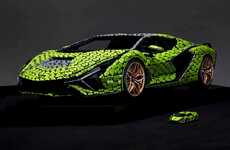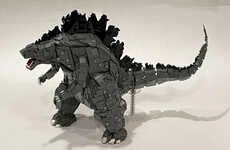'Tested' Created a Human-Sized LEGO Man for the San Diego Comic-Con
Riley von Niessen — July 30, 2016 — Art & Design
References: geek & designboom
LEGO characters don't look much like humans -- with block heads, claw hands and strangely square bodies, they were meant specifically to fit into the LEGO realm.
That didn't stop the 'Tested' team however, who decided to see what would happen if they were to bring a LEGO character to life by changing its traditional smooth yellow surface to be the color of human skin -- complete with discolorations and wrinkles.
Instead of the painted black dots for eyes and a curved line for a smile, Tested gave its rendition huge bug-like eyes and a mouth that's deeply ingrained into silicone skin. The resulting LEGO character is incredibly unsettling to look at, which garnered it immense attention at the San Diego Comic-Con event where it was shown.
Photo Credits: designboom, geek
That didn't stop the 'Tested' team however, who decided to see what would happen if they were to bring a LEGO character to life by changing its traditional smooth yellow surface to be the color of human skin -- complete with discolorations and wrinkles.
Instead of the painted black dots for eyes and a curved line for a smile, Tested gave its rendition huge bug-like eyes and a mouth that's deeply ingrained into silicone skin. The resulting LEGO character is incredibly unsettling to look at, which garnered it immense attention at the San Diego Comic-Con event where it was shown.
Photo Credits: designboom, geek
Trend Themes
1. Human-like LEGO Figures - Expanding the use of LEGO as a medium for human-like figures and creatures in industries such as film, animation, and advertising.
2. Hyper-realistic Character Design - Exploring the use of realistic aesthetics in character design and its potential in the toy and game industry.
3. Mash-up of Traditional and Modern Design - Blending traditional toy design with modern materials and techniques to create unique and unconventional toys.
Industry Implications
1. Toy and Game - Leveraging the use of realistic aesthetics to create new lines of toy products and games for children and adults.
2. Film - Incorporating new technologies to create hyper-realistic characters in movies, animation, and other forms of visual entertainment.
3. Advertising and Marketing - Developing creative advertisements featuring hyper-realistic character designs to promote products and services in unique and eye-catching ways.
3.4
Score
Popularity
Activity
Freshness






















